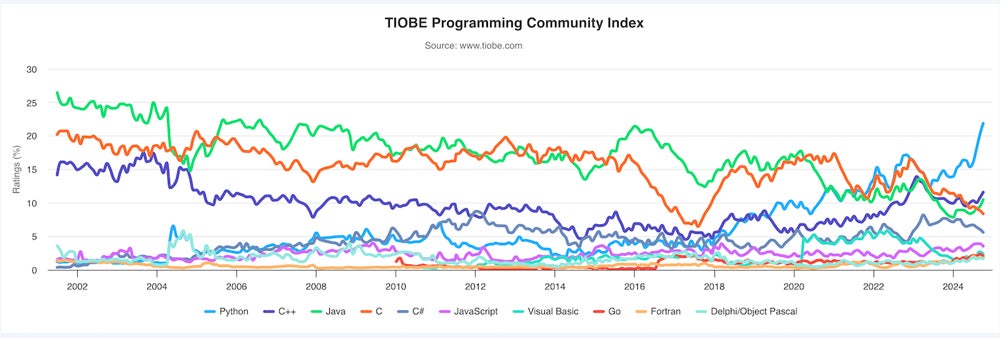TIOBE Programming Index October 2024: A New Era for Programming Languages
The landscape of programming languages is ever-evolving, and if there’s one thing I’ve learned through years of coding, it’s that remaining adaptable is key. Recent developments in the TIOBE Programming Community Index reveal exciting shifts, particularly the rise of Rust and the debut of Mojo, a language that’s already making headlines.
 The dynamic shifts illustrated in the TIOBE Index highlight the competitive landscape of programming languages.
The dynamic shifts illustrated in the TIOBE Index highlight the competitive landscape of programming languages.
Searching for Alternatives to Python
In a world where data is surging at an unprecedented rate, the demand for programming languages that can efficiently handle this data is palpable. According to Paul Jansen, CEO of TIOBE Software, the quest is on for languages that excel in data manipulation, speed, and security. As a developer, I find this pivot towards data-centric languages to be a natural reflection of our modern needs.
While Python remains an appealing option due to its simplicity and security, its performance limitations are pushing programmers to seek alternatives. The rise of languages like Rust illustrates this shift, with Rust climbing to the 13th position on the TIOBE Index, showcasing its growing adoption among the programming community.
Jansen points out, “Python is easy to learn and secure, but not fast.” As an advocate for beginner-friendly languages, I appreciate Python’s role in driving many newcomers into programming. However, I too have found myself exploring other languages as I tackle more complex projects that demand higher performance and efficiency. Rust seems to be positioned perfectly to fill this gap, with its emphasis on safety and concurrency.
Mojo Language Breaks Into the Top 50
Amidst the excitement surrounding established languages, a newcomer named Mojo has made a splash in the programming world. Launched just last year by Chris Lattner at Modular, this language rapidly ascended into the TIOBE Index, securing the 49th spot. Mojo promises a potent blend of Python’s simplicity and Swift’s speed, making it an intriguing option for future-facing projects.
Unlike C++, which is often favored for performance but criticized for security vulnerabilities, Mojo aims to tackle the weaknesses associated with low-level programming without compromising on accessibility. As many of us know from our programming journeys, having a reliable tool that is easy to use is invaluable. The potential of Mojo to facilitate programming for AI hardware while bypassing cumbersome architectures like NVIDIA’s CUDA is groundbreaking.
The Shift in Programming Culture
Developers today are seeking languages that not only provide functional capabilities but also fit a rapidly changing tech culture. The traditional hierarchy established by languages gets challenged as newer, more adaptable languages like Rust and Mojo capture the attention of a diverse coding community. I personally experienced this last year when I transitioned to Rust for several performance-critical applications, enjoying its robust error-checking and memory safety features that make my code more resilient.
Conclusion: An Exciting Future Ahead
The TIOBE Programming Index offers a glimpse into a future where programming languages do more than just solve problems—they empower developers to innovate boldly and work efficiently. With the rise of Rust and the entry of Mojo, we are poised to enter a new phase where the right tools can significantly impact productivity and creativity. It’s essential for developers to stay vigilant and experiment with these emerging languages, as they shape the next generation of coding.
The TIOBE Index reflects not just popularity, but also the shifting needs of developers, making it a critical resource for anyone serious about their programming career.
Visualizing the trends in programming languages gives insights into the future of development.


 Photo by
Photo by 












